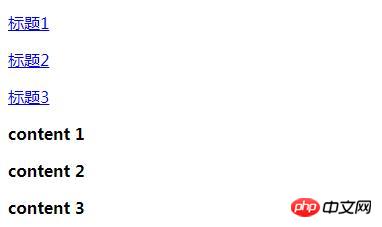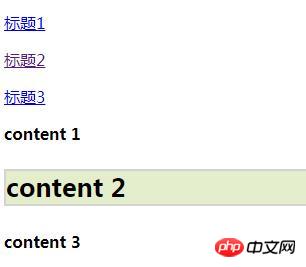 Web Front-end
Web Front-end
 CSS Tutorial
CSS Tutorial
 CSS3 target pseudo-class selector target that you don't know (code example analysis)
CSS3 target pseudo-class selector target that you don't know (code example analysis)
CSS3 target pseudo-class selector target that you don't know (code example analysis)
Recently, I have been sorting out the knowledge of CSS and found a lot of knowledge blind spots. In the final analysis, I underestimated CSS when I was learning it before, thinking it was too simple, and I should focus on JS. Today I will share a practical CSS3 knowledge, namely css3:target selector. You can also use css3:target to create a tab-like switching effect. I believe many people are not familiar with this attribute. Then read on.
1. How to use CSS3:target selector
target is one of the CSS3 pseudo-class selectors, used to match the target of a certain identifier in the text element. # The name of the anchor is the url in a file that links to the element that is linked to the target element. The :target selector can be used to style the currently active target element.
Specifically, the URL usually contains a #, followed by a name, such as #aa, :target matches the target element with the id "aa". For example: If there is an a tag in a page, its href is as follows: Button 3, there will also be elements with box as the id in the same page,
Then the href attribute of the a tag will be linked to #box, which is the target element selected by the box:target selector. It specifies Style is the style of the target element when a is linked to this element. For example, if you want to change the font size of the element that the link points to #tab, you can set it like this: #tab:target {font-size:30px}.
2. CSS3:target example
is implemented simply with CSS. Click title 1 to jump to content 1. Click title 2 to jump to content 2. Effect.
HTML part:
<p><a href="#news1">标题1</a></p> <p><a href="#news2">标题2</a></p> <p><a href="#news3">标题3</a></p> <p id="news1"><b>content 1</b></p> <p id="news2"><b>content 2</b></p> <p id="news3"><b>content 3</b></p>
CSS part:
:target
{
border: 2px solid #D4D4D4;
background-color: #e5eecc;
font-size:25px;
}Picture effect:


The above is the detailed content of CSS3 target pseudo-class selector target that you don't know (code example analysis). For more information, please follow other related articles on the PHP Chinese website!

Hot AI Tools

Undress AI Tool
Undress images for free

Undresser.AI Undress
AI-powered app for creating realistic nude photos

AI Clothes Remover
Online AI tool for removing clothes from photos.

Clothoff.io
AI clothes remover

Video Face Swap
Swap faces in any video effortlessly with our completely free AI face swap tool!

Hot Article

Hot Tools

Notepad++7.3.1
Easy-to-use and free code editor

SublimeText3 Chinese version
Chinese version, very easy to use

Zend Studio 13.0.1
Powerful PHP integrated development environment

Dreamweaver CS6
Visual web development tools

SublimeText3 Mac version
God-level code editing software (SublimeText3)

Hot Topics
 How to achieve wave effect with pure CSS3? (code example)
Jun 28, 2022 pm 01:39 PM
How to achieve wave effect with pure CSS3? (code example)
Jun 28, 2022 pm 01:39 PM
How to achieve wave effect with pure CSS3? This article will introduce to you how to use SVG and CSS animation to create wave effects. I hope it will be helpful to you!
 Use CSS skillfully to realize various strange-shaped buttons (with code)
Jul 19, 2022 am 11:28 AM
Use CSS skillfully to realize various strange-shaped buttons (with code)
Jul 19, 2022 am 11:28 AM
This article will show you how to use CSS to easily realize various weird-shaped buttons that appear frequently. I hope it will be helpful to you!
 How to hide elements in css without taking up space
Jun 01, 2022 pm 07:15 PM
How to hide elements in css without taking up space
Jun 01, 2022 pm 07:15 PM
Two methods: 1. Using the display attribute, just add the "display:none;" style to the element. 2. Use the position and top attributes to set the absolute positioning of the element to hide the element. Just add the "position:absolute;top:-9999px;" style to the element.
 How to enlarge the image by clicking the mouse in css3
Apr 25, 2022 pm 04:52 PM
How to enlarge the image by clicking the mouse in css3
Apr 25, 2022 pm 04:52 PM
Implementation method: 1. Use the ":active" selector to select the state of the mouse click on the picture; 2. Use the transform attribute and scale() function to achieve the picture magnification effect, the syntax "img:active {transform: scale(x-axis magnification, y Axis magnification);}".
 It turns out that text carousel and image carousel can also be realized using pure CSS!
Jun 10, 2022 pm 01:00 PM
It turns out that text carousel and image carousel can also be realized using pure CSS!
Jun 10, 2022 pm 01:00 PM
How to create text carousel and image carousel? The first thing everyone thinks of is whether to use js. In fact, text carousel and image carousel can also be realized using pure CSS. Let’s take a look at the implementation method. I hope it will be helpful to everyone!
 How to implement lace borders in css3
Sep 16, 2022 pm 07:11 PM
How to implement lace borders in css3
Sep 16, 2022 pm 07:11 PM
In CSS, you can use the border-image attribute to achieve a lace border. The border-image attribute can use images to create borders, that is, add a background image to the border. You only need to specify the background image as a lace style; the syntax "border-image: url (image path) offsets the image border width inward. Whether outset is repeated;".
 How to set animation rotation speed in css3
Apr 28, 2022 pm 04:32 PM
How to set animation rotation speed in css3
Apr 28, 2022 pm 04:32 PM
In CSS3, you can use the "animation-timing-function" attribute to set the animation rotation speed. This attribute is used to specify how the animation will complete a cycle and set the speed curve of the animation. The syntax is "element {animation-timing-function: speed attribute value;}".
 Can css3 linear gradient achieve triangles?
Apr 25, 2022 pm 02:47 PM
Can css3 linear gradient achieve triangles?
Apr 25, 2022 pm 02:47 PM
CSS3 linear gradient can realize triangles; just create a 45-degree linear gradient and set the gradient color to two fixed colors, one is the color of the triangle and the other is transparent color. The syntax "linear-gradient(45deg, color value , color value 50%, transparent color 50%, transparent color 100%)".






